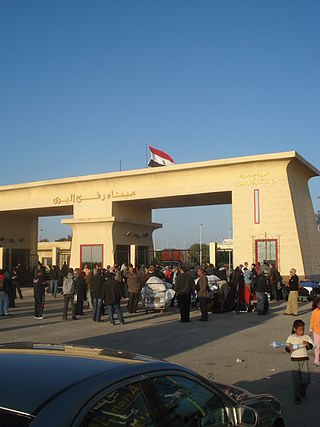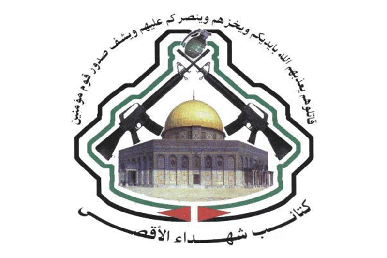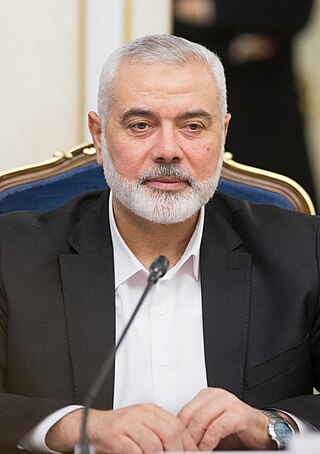Related Research Articles
This page is a partial listing of incidents of violence in the Israeli-Palestinian conflict in 2004.

The Popular Resistance Committees is a coalition of a number of armed Palestinian groups opposed to what they regard as the conciliatory approach of the Palestinian Authority and Fatah towards Israel.
This page is a partial listing of incidents of violence in the Israeli-Palestinian conflict in 2005.

The Fatah–Hamas conflict is an ongoing political and strategic conflict between Fatah and Hamas, the two main Palestinian political parties in the Palestinian territories, leading to the Hamas takeover of the Gaza Strip in June 2007. The reconciliation process and unification of Hamas and Fatah administrations remains unfinalized and the situation is deemed a frozen conflict.

The 2006 Gaza–Israel conflict, known in Israel as Operation Summer Rains, was a series of battles between Palestinian militants and the Israel Defense Forces (IDF) during summer 2006, prompted by the capture of Israeli soldier Gilad Shalit by Palestinian militants on 25 June 2006. Large-scale conventional warfare occurred in the Gaza Strip, starting on 28 June 2006, which was the first major ground operation in the Gaza Strip since Israel's unilateral disengagement plan was implemented between August and September 2005.
This is the Timeline of the Israeli–Palestinian conflict in 2007.

In 2008, Israel sought to halt the rocket and mortar fire from Gaza that killed four Israeli civilians that year and caused widespread trauma and disruption of life in Israeli towns and villages close to the Gaza border. In addition, Israel insisted that any deal include an end to Hamas's military buildup in Gaza, and movement toward the release of Corporal Gilad Shalit. Hamas wanted an end to the frequent Israeli military strikes and incursions into Gaza, and an easing of the economic blockade that Israel has imposed since Hamas took over the area in 2007.

On 23 January 2008, Hamas militants in the Gaza Strip set off an explosion near the Rafah border crossing, destroying part of the 2003 wall. The United Nations estimates that as many as half the 1.5 million population of the Gaza Strip crossed the border into Egypt seeking food and supplies. Due to fears that militants would acquire weapons in Egypt, Israeli police went on increased alert.

Shuja'iyya, also Shejaiya, Shijaiyeh, Shujayya, Shuja'ia, Shuja'iya, is a largely destroyed neighborhood district of the Palestinian city of Gaza and one of the largest neighborhoods in Gaza, once holding 92,000 to 100,000 residents. It is located east of Gaza's city center, and its nucleus is situated on a hill located across the main Salah al-Din Road that runs north-south throughout the Gaza Strip. Shuja'iyya contains several ancient structures, mosques and tombs. The Commonwealth War Cemetery is located 2 kilometres (1.2 mi) north of the commercial center of the neighborhood.
Operation Bringing Home the Goods was a raid launched by the Israel Defense Forces (IDF) on March 14, 2006, on a Palestinian prison in Jericho. The prison held several prisoners wanted by Israel, whose incarceration was monitored by British and American wardens. In early 2006, the newly elected Hamas government announced that it intended to release the prisoners.
Events in the year 2004 in Israel.
Events in the year 2005 in the Palestinian territories.
Events in the year 2004 in the Palestinian territories.

The 2006 Gaza cross-border raid was an armed incursion carried out by seven or eight Gazan Palestinian militants on 25 June 2006 who attacked Israel Defense Forces (IDF) positions near the Kerem Shalom Crossing through an attack tunnel. In the attack, two IDF soldiers and two Palestinian militants were killed, four IDF soldiers were wounded, one of whom was Gilad Shalit, who was captured and taken to the Gaza Strip.

The governance of the Gaza Strip since the Hamas takeover of the Gaza Strip in June 2007 has been carried out by Hamas. The Hamas government in Gaza was led by Ismail Haniyeh from 2007 until February 2017, when Haniyeh was replaced as leader of Hamas in the Gaza Strip by Yahya Sinwar. As of November 2023, Yahya Sinwar continues to be the leader of Hamas in the Gaza Strip. Due to the ongoing Israel–Hamas war, Hamas lost control of most of the northern part of the Gaza Strip.

The al-Aqsa Martyrs' Brigades is a coalition of Palestinian armed groups in the West Bank. The organization has been designated as a terrorist organization by Israel, the European Union, Canada, Japan, New Zealand, and the United States.

Ismail Haniyeh is a Palestinian politician who is seen as the overall political leader of Hamas, the current chairman of Hamas’s political bureau; as of 2023, Haniyeh lives in Qatar.
The following is a timeline of the 2014 Gaza War. Over 2014, Palestinians suffered the highest number of civilian casualties since the Six-Day War in 1967, according to a United Nations report, given the July–August conflict, and rising tolls in the West Bank and East Jerusalem. A spike in Israeli casualties also occurred. 2,256 Palestinians and 85 Israelis died, while 17,125 Palestinians, and 2,639 Israelis suffered injuries.
References
- ↑ 150 Fatah men enter Israel after fleeing Gaza violence, by Yuval Azoulay and Avi Issacharoff, Haaretz, August 3, 2008
- ↑ Hilles family: Hamas will pay for blood spilt
- ↑ Gaza men arrive in Jericho, by Al Jazeera, last updated August 6, 2008
- ↑ "IDF: Hilles clan won't boost terrorism". Archived from the original on 2011-05-11. Retrieved 2020-01-14.